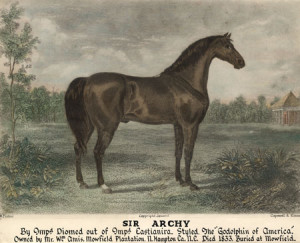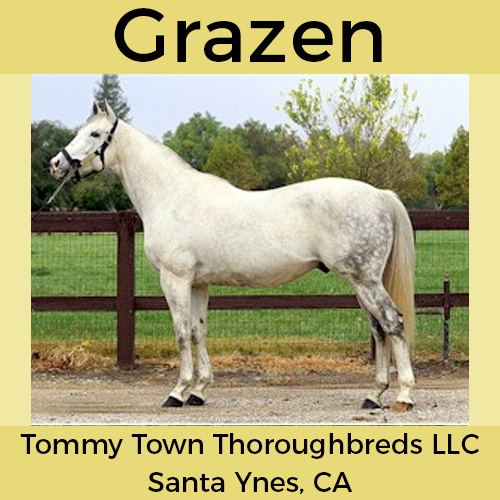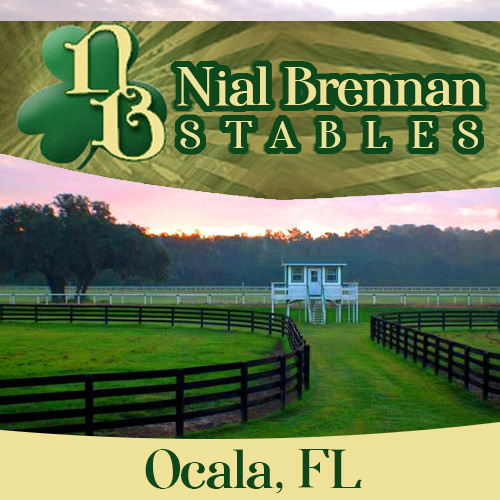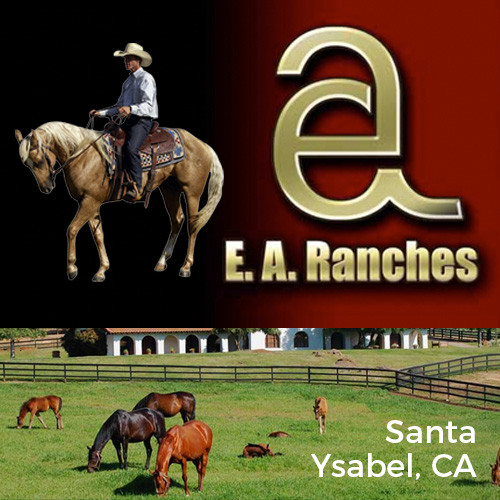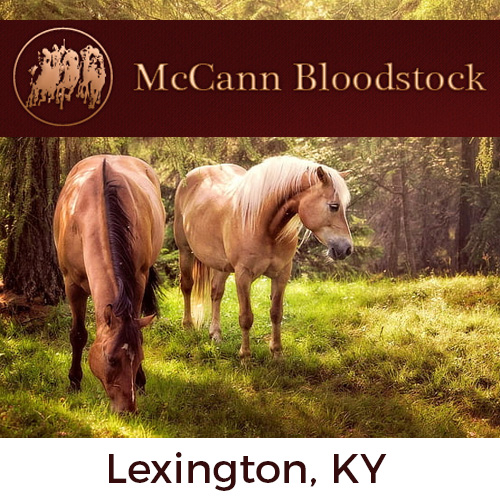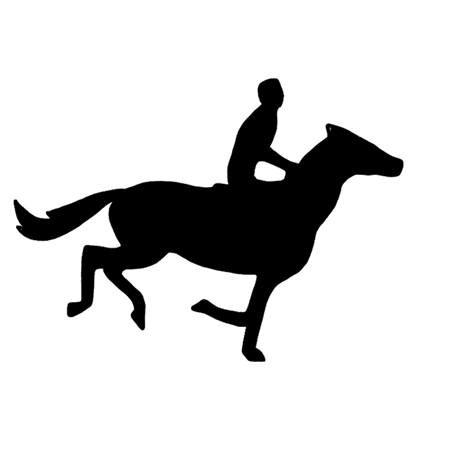Thoroughbred People's Equine Legends Series: Sir Archy
Also referred to as Archy, Sir Archie or Archie, the dark bay son of the first Epsom victor Diomed and the Rockingham mare Castianira, was born in the spring of 1805 at the Ben Lomond Plantation near the James River in Virginia. Little did Colonel John Tayloe III and Captain Archibald Randolph know the foal they had bred and initially named Robert Burns, would be hailed as the first great Thoroughbred sire to hit the ground in the United States and that his influence on the breed would extend to him being referred to as “The Godolphin Arabian of the American Turf.”
Diomed was most likely selected as a sire because not only was he was a superior racehorse, but as a stallion he was nearly unrivaled in producing top quality stock. Imported to America at the end of his stud career, Diomed passed in 1808 before one of his greatest sons ever commenced his career.
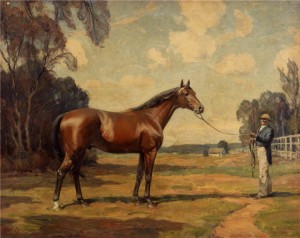 While he was still a youngster, Sir Archy’s name was altered by Tayloe to honor Randolph, but the two friends never raced him in either of their stable’s colors. As a 2-year-old, the colt, who only possessed a splash of white on his hind pastern, was purchased for $400 and an unnamed filly by Ralph Wormeley IV. His new owner, however, determined that racing was no longer for him shortly after acquiring Sir Archy and put the horse on the market. Wormeley had no offer for the colt, so he dropped him in the box for the Washington D.C. Sweepstakes in the fall of his 3-year-old year.
While he was still a youngster, Sir Archy’s name was altered by Tayloe to honor Randolph, but the two friends never raced him in either of their stable’s colors. As a 2-year-old, the colt, who only possessed a splash of white on his hind pastern, was purchased for $400 and an unnamed filly by Ralph Wormeley IV. His new owner, however, determined that racing was no longer for him shortly after acquiring Sir Archy and put the horse on the market. Wormeley had no offer for the colt, so he dropped him in the box for the Washington D.C. Sweepstakes in the fall of his 3-year-old year.
Unfortunately, the colt was not in his best form, as he was struggling to recover from a case of strangles and came home well in arrears of Bright Phoebus. Wormeley decided his horse should compete knowing he was not in peak condition because he did not want to pay the stipend for forfeiture. Although still ill, Sir Archy performed for the second time at the Fairfield Racecourse in Richmond. It appeared the outcome of this race would be a repeat of what had transpired in his first racing engagement, but Sir Archy did manage to come home third to True Blue in the third heat. This effort attracted the attention of none other than Colonel William R. Johnson. Known as the “Napoleon of the Turf,” Johnson did not tarry and bought Sir Archy for $1,500.
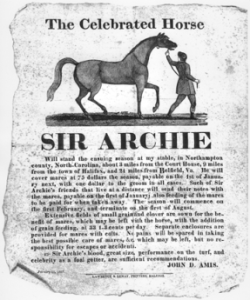 It was under Johnson’s tutelage and that of his conditioner Arthur Taylor that Sir Archy served notice he was a force to be reckoned with. At age four, the bay stallion captured four of five races, which were all contested in four one mile heats. Despite not racing frequently, Sir Archy proved his dominance by defeating all the top class runners of his day such as Wrangler, Tom Tough, Palafox, Minerva, Ratray, Gallatin and Blank. In fact, in his victory against Blank, who was highly touted, the stallion ran the fastest time ever witnessed below the James River, which was 7:52.
It was under Johnson’s tutelage and that of his conditioner Arthur Taylor that Sir Archy served notice he was a force to be reckoned with. At age four, the bay stallion captured four of five races, which were all contested in four one mile heats. Despite not racing frequently, Sir Archy proved his dominance by defeating all the top class runners of his day such as Wrangler, Tom Tough, Palafox, Minerva, Ratray, Gallatin and Blank. In fact, in his victory against Blank, who was highly touted, the stallion ran the fastest time ever witnessed below the James River, which was 7:52.
Johnson, who obviously knew horseflesh, felt very few horses were capable of holding a candle to Sir Archy.
“I have only to say that, in my opinion, Sir Archy is the best horse I ever saw, and I well know that I never had any thing with one that at all his equal,” he wrote in letter that was originally published in the December 1829 edition of the American Turf Register and Sporting Magazine. “And this I will back; for, if any horse in the world will run against him at half way ground, four mile heats, according to the rules of racing, you may consider me $5000 with you on him. He was in good condition this fall, (1809) and has not run with any horse that could put him to half speed towards the end of the race.”
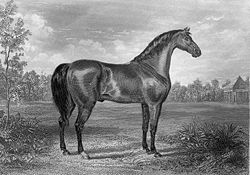 After his triumph over Blank, Johnson, ever the consummate wagering man, put up a $10,000 bet saying Sir Archy would beat any American horse. The public must have concurred for no one was willing to accept Johnson’s challenge. With no one to run against, Sir Archy was retired in 1809 with a record of 7-4-1-0. He changed hands yet again, as General William Richardson Davie, who was the governor of North Carolina, purchased him for $5,000. He commenced his stud career for Davie and then upon Davie’s passing for his son until 1818 in Virginia. He fee was initially $50 a cover, which after his first crops hit the ground was increased to $75 and later to $100, which was quite pricey for that day and age.
After his triumph over Blank, Johnson, ever the consummate wagering man, put up a $10,000 bet saying Sir Archy would beat any American horse. The public must have concurred for no one was willing to accept Johnson’s challenge. With no one to run against, Sir Archy was retired in 1809 with a record of 7-4-1-0. He changed hands yet again, as General William Richardson Davie, who was the governor of North Carolina, purchased him for $5,000. He commenced his stud career for Davie and then upon Davie’s passing for his son until 1818 in Virginia. He fee was initially $50 a cover, which after his first crops hit the ground was increased to $75 and later to $100, which was quite pricey for that day and age.
In 1818, Sir Archy acquired yet another new owner in William Amis. For the last seventeen years of his breeding career he held court at Amis’s North Carolina plantation Mowfield near the Roanoke River in Northhampton County. He was retired in 1831 at age 26 and died on June 7, 1933 at age 28. It was estimated he earned more than $76,000 in stud fees during his time at Mowfield.
Sir Archy was so stellar in the breeding shed that in 1827 the Washington DC Jockey Club and the Maryland Jockey Club placed restrictions on the number of horses that would be allowed to run in their races. Although there were other details involved, it served to eliminate all horses sired by Sir Archy. His sons and daughters were so prolific and inbreeding to his line and the Diomed line was so fashionable, only those horses produced from it were placed into competition.
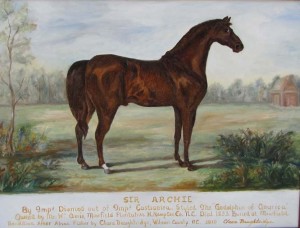 His breeder Randolph referred to him as, “A horse of commanding size, with great power and substance. He is eminently superior in all those points indispensable to the turf horse and mainly contributory to strength and action. His shoulder, the most material part of the horse, is strikingly distinguished, being very deep, fairly mounting up to the top of the withers, and obliquely inclined to the hips. His girth is full and deep, back short and strong, thighs and arms long and muscular, his bone good. His front appearance is fine and commanding-his head and neck are well formed, the latter rising well out of his withers. Take Sir Archy upon the whole and he has more size, power and substance than we often see combined in the full bred horse.”
His breeder Randolph referred to him as, “A horse of commanding size, with great power and substance. He is eminently superior in all those points indispensable to the turf horse and mainly contributory to strength and action. His shoulder, the most material part of the horse, is strikingly distinguished, being very deep, fairly mounting up to the top of the withers, and obliquely inclined to the hips. His girth is full and deep, back short and strong, thighs and arms long and muscular, his bone good. His front appearance is fine and commanding-his head and neck are well formed, the latter rising well out of his withers. Take Sir Archy upon the whole and he has more size, power and substance than we often see combined in the full bred horse.”
More than a decade after Sir Archy’s first runners began to dominate their competition his prowess in the breeding shed was being compared to his sire’s. That is when rumors started to float around the stallion was not the progeny of Diomed, but of another horse named Gabriel, who had fathered quality runners Postboy and Oscar.
Tayloe responded to these falsehoods by a letter that was published in American Farmer on August 11, 1826.
“To your inquiry relative to the sireship of Sir Archy, I have to observe in reply, that I sold one half of Castianira, the dam of Sir Archy, to Mr. Archibald Randolph before Sir Archy was foaled on the south side of James River in the spring of 1805 the joint property of Mr. Randolph and myself. I believe that Gabriel was alive in 1804, but I am very confident he never covered at the stand with Diomed. Gabriel and Sir Archy are something alike in form, but not in color, Gabriel being brown-can’t speak positively as to marks, but have no hesitation in saying there can be no doubt of Sir Archy’s being got by Diomed. Castianira was a dark brown, almost black mare.”
People could try to cast any doubts they wished on Sir Archy’s origin of birth and bloodline, but it could not be denied how tremendous he was as a sire and grandsire. As a sire he was responsible for 31 stakes victors and even influenced the development of the American Quarter Horse through his son Copperbottom. Some of this top horses include Timoloen (1814), Bertrand (1826), Sir Charles (1816), who was the leading sire in 1830, 1831, 1832, 1833 and 1836, Sumpter (1818), Stockholder (1819), Lady Lightfoot (1812) who gave birth to Black Maria, Reality (1819), Henry (1819), Sally Hope (1822) and Flirtilla (1818). He was also the grandsire of Bonnets O Blue, who was a great race mare, who in turn gave birth to Fashion and was the grandsire of Boston, America’s first outstanding racehorse, who fathered the renowned Lexington.
Sir Archy, who stood at 16 hands, was one of the first horses inducted into the National Museum of Racing and Hall of Fame in Saratoga Springs, New York, and is still honored today at two different gravesites. Over the passage of time, it is unknown where the horse is actually buried and what attempts would have been made to move him, but there is a marker at one location in Virginia where he was born. This signage states Sir Archy lies there with his groom and his dog and the burial area is marked by a stone wall that was erected in 1972.
The second location that claims to possess Sir Archy’s bones is where he spent the majority of his life: Mowfield Plantation. His exact whereabouts on the property are not certain, but the original plantation house has been refurbished and still remains.
Although his final resting place has not been determined, it is certainly a fact Sir Archy’s contributions to racing are of a magnitude and scope which not many other horses throughout the history of the turf can ever equal or surpass. Barbaro, Cigar, Affirmed, Seattle Slew, Secretariat, Seabiscuit and Man O’ War are all directly descended from Sir Archy and many more Thoroughbred champions carrying his DNA will continue to cross the finish line for years to come.
Grazen - $6,000 Live Foal
http://www.tommytownfarms.com/stallions/grazen
